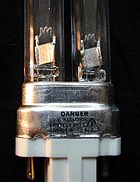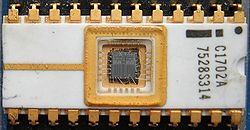
Germicidal lamp
Encyclopedia



Ultraviolet
Ultraviolet light is electromagnetic radiation with a wavelength shorter than that of visible light, but longer than X-rays, in the range 10 nm to 400 nm, and energies from 3 eV to 124 eV...
light (UVC). This short-wave ultraviolet light disrupts DNA base pairing causing thymine
Thymine
Thymine is one of the four nucleobases in the nucleic acid of DNA that are represented by the letters G–C–A–T. The others are adenine, guanine, and cytosine. Thymine is also known as 5-methyluracil, a pyrimidine nucleobase. As the name suggests, thymine may be derived by methylation of uracil at...
-thymine dimers leading to death of bacteria on exposed surfaces. It can also be used to produce ozone for water disinfection.
There are two common types available:
- Low pressure lamps
- Medium pressure lamps
Low pressure lamps
Low-pressure lamps are very similar to a fluorescent lampFluorescent lamp
A fluorescent lamp or fluorescent tube is a gas-discharge lamp that uses electricity to excite mercury vapor. The excited mercury atoms produce short-wave ultraviolet light that then causes a phosphor to fluoresce, producing visible light. A fluorescent lamp converts electrical power into useful...
, with a wavelength
Wavelength
In physics, the wavelength of a sinusoidal wave is the spatial period of the wave—the distance over which the wave's shape repeats.It is usually determined by considering the distance between consecutive corresponding points of the same phase, such as crests, troughs, or zero crossings, and is a...
of 253.7 nm.
The most common form of germicidal lamp looks similar to an ordinary fluorescent lamp but the tube contains no fluorescent phosphor
Phosphor
A phosphor, most generally, is a substance that exhibits the phenomenon of luminescence. Somewhat confusingly, this includes both phosphorescent materials, which show a slow decay in brightness , and fluorescent materials, where the emission decay takes place over tens of nanoseconds...
. In addition, rather than being made of ordinary borosilicate glass
Borosilicate glass
Borosilicate glass is a type of glass with the main glass-forming constituents silica and boron oxide. Borosilicate glasses are known for having very low coefficients of thermal expansion , making them resistant to thermal shock, more so than any other common glass...
, the tube is made of fused quartz
Fused quartz
Fused quartz and fused silica are types of glass containing primarily silica in amorphous form. They are manufactured using several different processes...
. These two changes combine to allow the 253.7 nm ultraviolet light produced by the mercury
Mercury (element)
Mercury is a chemical element with the symbol Hg and atomic number 80. It is also known as quicksilver or hydrargyrum...
arc to pass out of the lamp unmodified (whereas, in common fluorescent lamps, it causes the phosphor to fluoresce
Fluorescence
Fluorescence is the emission of light by a substance that has absorbed light or other electromagnetic radiation of a different wavelength. It is a form of luminescence. In most cases, emitted light has a longer wavelength, and therefore lower energy, than the absorbed radiation...
, producing visible light
Visible spectrum
The visible spectrum is the portion of the electromagnetic spectrum that is visible to the human eye. Electromagnetic radiation in this range of wavelengths is called visible light or simply light. A typical human eye will respond to wavelengths from about 390 to 750 nm. In terms of...
). Germicidal lamps still produce a small amount of visible light due to other mercury radiation bands.
An older design looks like an incandescent lamp but with the envelope containing a few droplets of mercury. In this design, the incandescent filament heats the mercury, producing a vapor which eventually allows an arc to be struck, short circuit
Short circuit
A short circuit in an electrical circuit that allows a current to travel along an unintended path, often where essentially no electrical impedance is encountered....
ing the incandescent filament.
Medium pressure lamps
Medium-pressure lamps are much more similar to HID lamps than fluorescent lamps.These lamps radiate a broad-band UV-C radiation, rather than a single line. They are widely used in industrial water treatment, because they are very intense radiation sources. They are as efficient as low-pressure lamps. Medium-pressure lamps produces very bright bluish white light.
Auxiliary equipment
As with all gas discharge lamps, all of the styles of germicidal lamps exhibit negative resistanceNegative resistance
Negative resistance is a property of some electric circuits where an increase in the current entering a port results in a decreased voltage across the same port. This is in contrast to a simple ohmic resistor, which exhibits an increase in voltage under the same conditions. Negative resistors are...
and require the use of an external ballast to regulate the current flow through them. The older lamps that resembled an incandescent lamp were often operated in series with an ordinary 40 W incandescent "appliance" lamp; the incandescent lamp acted as the ballast for the germicidal lamp.
Uses
Germicidal lamps are used to sterilize workspaces and tools used in biology laboratories and medical facilities. If the quartz envelope transmits wavelengths shorter than 253.7nm, they can also be used wherever ozone is desired, for example, in the sanitizing systems of hot tubHot tub
A hot tub is a large tub or small pool full of heated water and used for soaking, relaxation, massage, or hydrotherapy. In most cases, they have jets for massage purposes. Hot tubs are usually located outdoors, and are often sheltered for protection from the elements, as well as for privacy....
s and aquarium
Aquarium
An aquarium is a vivarium consisting of at least one transparent side in which water-dwelling plants or animals are kept. Fishkeepers use aquaria to keep fish, invertebrates, amphibians, marine mammals, turtles, and aquatic plants...
s. They are also used by geologist
Geologist
A geologist is a scientist who studies the solid and liquid matter that constitutes the Earth as well as the processes and history that has shaped it. Geologists usually engage in studying geology. Geologists, studying more of an applied science than a theoretical one, must approach Geology using...
s to provoke fluorescence in mineral
Mineral
A mineral is a naturally occurring solid chemical substance formed through biogeochemical processes, having characteristic chemical composition, highly ordered atomic structure, and specific physical properties. By comparison, a rock is an aggregate of minerals and/or mineraloids and does not...
samples, aiding in their identification. In this application, the light produced by the lamp is usually filtered
Filter (optics)
Optical filters are devices which selectively transmit light of different wavelengths, usually implemented as plane glass or plastic devices in the optical path which are either dyed in the mass or have interference coatings....
to remove as much visible light as possible, leaving just the UV light.

EPROM
An EPROM , or erasable programmable read only memory, is a type of memory chip that retains its data when its power supply is switched off. In other words, it is non-volatile. It is an array of floating-gate transistors individually programmed by an electronic device that supplies higher voltages...
s; the ultraviolet photons are sufficiently energetic to allow the electrons trapped on the transistors' floating gates to tunnel through the gate insulation, eventually removing the stored charge that represents binary ones and zeroes.
Germicidal lamps are also used in waste water treatment in order to kill microorganisms.
Ozone production
For most purposes, ozone production would be a detrimental side effect of lamp operation. To prevent this, most germicidal lamps are treated to absorb the 185nm mercury emission line (which is the longest wavelength of mercury light which will ionize oxygen).In some cases (such as water sanitization), ozone production is precisely the point. This requires specialized lamps which do not have the surface treatment.
Safety concerns
Short-wave UV light is harmful to humans. In addition to causing sunburnSunburn
A sunburn is a burn to living tissue, such as skin, which is produced by overexposure to ultraviolet radiation, commonly from the sun's rays. Usual mild symptoms in humans and other animals include red or reddish skin that is hot to the touch, general fatigue, and mild dizziness. An excess of UV...
and (over time) skin cancer
Skin cancer
Skin neoplasms are skin growths with differing causes and varying degrees of malignancy. The three most common malignant skin cancers are basal cell cancer, squamous cell cancer, and melanoma, each of which is named after the type of skin cell from which it arises...
, this light can produce extremely painful inflammation of the cornea
Cornea
The cornea is the transparent front part of the eye that covers the iris, pupil, and anterior chamber. Together with the lens, the cornea refracts light, with the cornea accounting for approximately two-thirds of the eye's total optical power. In humans, the refractive power of the cornea is...
of the eye, which may lead to temporary or permanent vision impairment. It can also damage the retina
Retina
The vertebrate retina is a light-sensitive tissue lining the inner surface of the eye. The optics of the eye create an image of the visual world on the retina, which serves much the same function as the film in a camera. Light striking the retina initiates a cascade of chemical and electrical...
of the eye. For this reason, the light produced by a germicidal lamp must be carefully shielded against both direct viewing and reflections and dispersed light that might be viewed.

